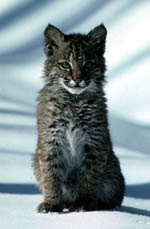![]() Download Story
Download Story
By JORDAN TRAVIS
Capital News Service
Oct. 2, 2009
 LANSING – The bobcat hunting and trapping season in the Upper Peninsula will start three months later because of an apparent drop in the bobcat population.
LANSING – The bobcat hunting and trapping season in the Upper Peninsula will start three months later because of an apparent drop in the bobcat population.
The UP season will be shortened from four months and a week to two months. The start date for the trapping season, originally Oct. 25, is now Dec. 1, and the hunting season now begins on New Year’s Day.
The Department of Natural Resources (DNR) opted to shorten the season rather than reduce the bag limit from two to one bobcat, a move that some conservation and hunter advocacy organizations recommended.
Hunters and trappers still have a choice of where they can take their season limit. Both cats can be taken in the UP except for Drummond Island, or one cat can be taken from each peninsula.
Adam Bump, a DNR specialist on furbearing animals, said that the decision was a compromise between meeting the needs of hunters and preserving the bobcat population.
In 2007, hunters and trappers reported killing 660 bobcats.
Hunting associations and biologists within the department had expressed concern about a decline in bobcat numbers.
Bump said the DNR is still trying to determine the causes of the decline, citing habitat loss as one possibility.
Amy Spray, a resource policy specialist with Michigan United Conservation Clubs (MUCC), said that the change in season length came amidst a disagreement between hunters and trappers. Trappers must set multiple traps to catch a single bobcat so a smaller limit greatly increases the chance that a trapper will kill an extra bobcat over the course of the season, she said.
“We support sound scientific management,” which means finding a balance between recreational opportunity and population management, Spray added. MUCC will watch to see how a shortened season affects bobcat hunters and trappers, she said.
In the Lower Peninsula, the season will remain unchanged.
Patrick Rusz, director of wildlife programs for the Michigan Wildlife Conservancy in Bath, said bobcats have a wide range and a diet that doesn’t depend on any one animal. Because they do not need large, unbroken areas of habitat, they aren’t as sensitive to habitat loss as other wildlife, he said.
“The bobcat has been doing pretty well and extending its range” within the state, Rusz said. He added that it isn’t unusual to see one considerably further south than they were once believed to venture.
Bobcats are members of the lynx family of felines and are found throughout most of the continental U.S., Mexico and parts of Canada. They feed on small mammals, especially rabbits. They average 15 to 30 pounds, 30 to 40 inches in length and 20 inches in height at the shoulders.
© 2009, Capital News Service, Michigan State University School of Journalism. Not to be reproduced without permission.
Spartan Newsroom - News and information from student journalists at the Michigan State University School of Journalism
Spartan Newsroom (https://news.jrn.msu.edu/2009/10/state-changes-bobcat-season-in-up/)